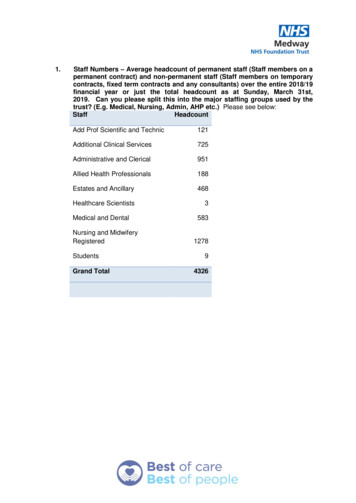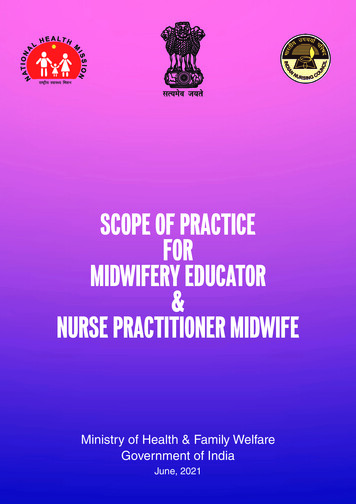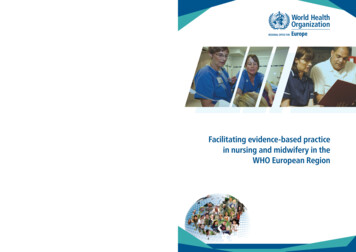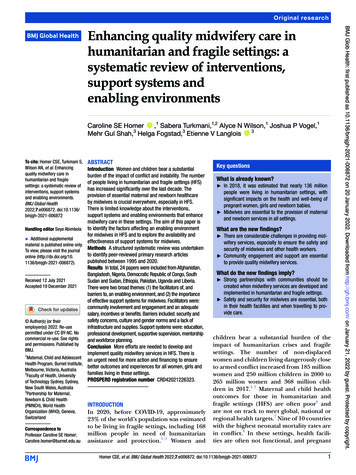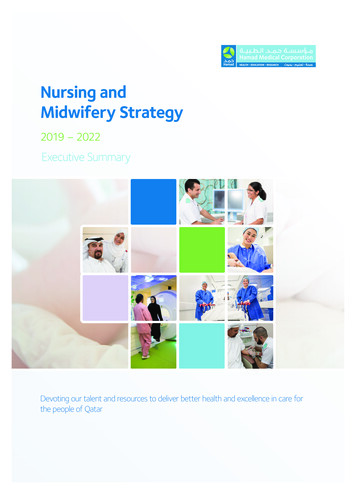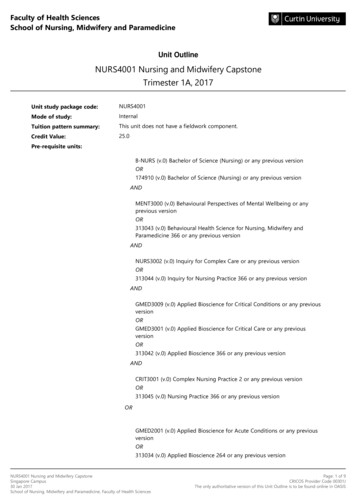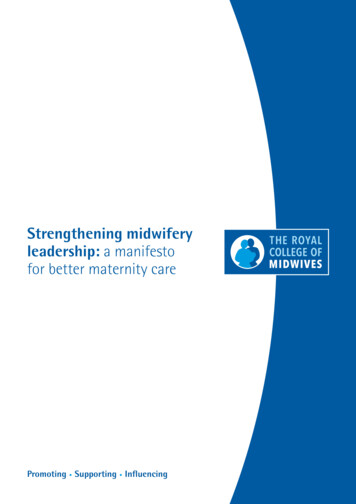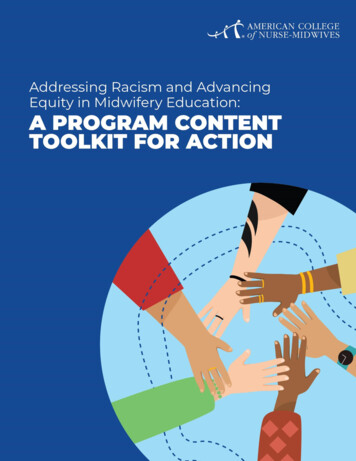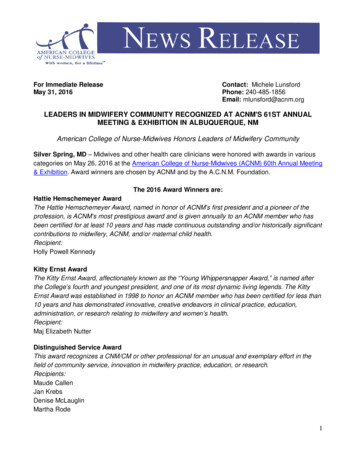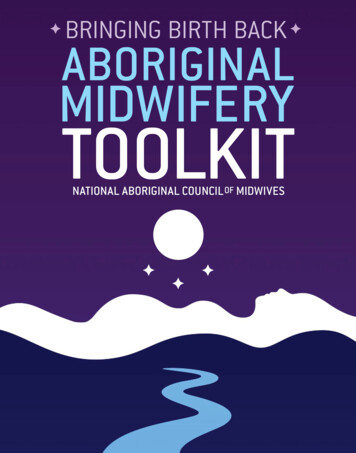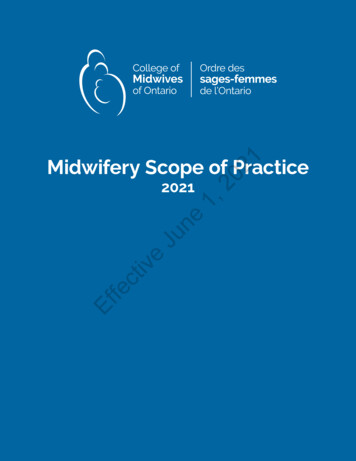
Transcription
EffectiveJune1,20212021Midwifery Scope of Practice
Midwifery Scope of Practice2021Introduction. 22Legislative Context in Ontario: Scope of Practice Scheme. 32022.2Controlled Acts. 32.2.1Delegation of Controlled Acts. 42.2.2Exceptions to Controlled Acts under the RHPA. 42.3Laboratory and Specimen Collection Centre Licensing Act. 52.4The Public Domain. 5June1,Scope of Practice Statement. 3Legislative Scope of Midwifery Practice.6Scope of Practice Statement - Key Concepts and Definitions.63.2Controlled Acts Authorized to Midwives.83.3Practising to the Full Legislative Scope.11ctive3.1When a Client’s Condition is Outside the Legislative Scope of Practice.134.14.2fe42.1Transfer Care to Another Provider.13Ef311Working Under Delegation.145When Elements of Care are Outside the Legislative Scope of Practice.146Conclusion.15Appendix A: Decision-Making Tool for a Midwife Accepting a Delegation.16Appendix B: Decision-Making Tool for a Midwife Determining Scope of Practice.17COLLEGE OF MIDWIVES OF ONTARIO MIDWIFERY SCOPE OF PRACTICE 20211
1INTRODUCTIONThe role of the College of Midwives of Ontario (College) is to ensure that midwifery services provided to the public are delivered in a safe and ethical mannerby midwives. Part of this involves ensuring that midwives understand their scopeof practice and practise within it.The purpose of this document is to describe the midwifery scope of practice setout in the Midwifery Act, 19911, its regulations and other legislation that governthe midwifery profession in Ontario. In addition to providing information aboutscope, this document also provides regulatory guidance to midwives about work-1ing within the midwifery scope of practice and what to do when a client’s clinical202condition or the care they required is no longer in the midwifery scope of practice.This document is designed to assist midwives to ensure their practice complieswith legislation. It does not replace professional and clinical judgment, and1,midwives remain accountable for their practice. The interpretations in thedocument reflect the context at the time of the document’s implementation,neand interpretations may change as midwifery practice develops. To reflectpossible changes, the College will update the document from time to time. PleaseJunote that the document does not replace the authority of the Midwifery Act, 1991,and other legislation governing midwifery. If, after reviewing this document,eyou have questions involving scope of practice and need clarification you shouldivcontact the College for professional practice advice or seek the advice of a lawyer.ctThis document intended for use by midwives and their interprofessionalfecolleagues including physicians, nurses, respiratory therapists, and pharmacistsas well as by health care organizations that oversee institutions where midwivesEfpractise. The document is also intended to help clients understand the spectrumof care midwives are permitted to provide.Throughout the document the terms “must” and “should” are used. The use of“must” indicates a requirement (e.g., a legislative requirement or a standard ofpractice) while the use of “should” indicates a recommendation.1Midwifery Act, 1991, S.O. 1991, c. 31 [Midwifery Act].COLLEGE OF MIDWIVES OF ONTARIO MIDWIFERY SCOPE OF PRACTICE 20212
2LEGISLATIVE CONTEXT IN ONTARIO:SCOPE OF PRACTICE SCHEMEA health care professional’s scope of practice is the range of activities,including decisions and procedures, that they are authorized to perform by thelaws that govern their profession. In Ontario, the scope of practice scheme isset out in the Regulated Health Professions Act, 1991 (RHPA)2 and consists of twomain elements: a scope of practice statement and the controlled acts authorizedto each profession.Scope of Practice Statement12.1202The scope of practice statement is found in each profession-specific Act, and itdefines, in broad terms, the outer parameters of what that particular professioncan do. For example, the midwifery scope of prac-tice is set out in the Midwifery Act, 1991, which is1,the profession-specific Act for midwives. Profession-specific Acts of other health care profession-neals include the Medicine Act, 1991 for physicians, the2.2Controlled Actse1991 for pharmacists.JuNursing Act, 1991 for nurses, and the Pharmacy Act,The midwifery scope ofpractice is set out in theMidwifery Act, 1991, whichis the profession-specificAct for midwives.ivControlled acts are set out in the RHPA and are procedures, tests, and treatmentsctthat are considered to pose a risk of harm when performed by someone who isfenot qualified to perform them. Because there is implicit risk of harm in the performance of controlled acts, they can be performed only by the regulated healthEfprofessionals who are authorized by their profession-specific Acts (e.g. the Midwifery Act, 1991) to perform them. There are 14 controlled acts listed in the RHPA3.Some professions do not have any controlled acts. Other professions, like midwifery, are authorized to perform many controlled acts. No profession is authorized to perform all controlled acts.Controlled acts can be authorized to professions either in their entirety or onlypartially depending on what is considered appropriate for that profession’s scopeof practice. For example, the controlled act of managing labour or conducting the2Regulated Health Professions Act, 1991, S.O. 1991, c.18 [RHPA].3RHPA at s. 27(2)12.COLLEGE OF MIDWIVES OF ONTARIO MIDWIFERY SCOPE OF PRACTICE 20213
delivery of a baby4 is authorized to physicians in its entirety but is authorizedto midwives only partially. This means that physicians can perform all of thecontrolled act of managing labour or conducting the delivery of a baby withoutlimitations; whereas for midwives this controlled act is limited, and they canonly manage labour and conduct spontaneous normal vaginal deliveries5.2.2.1Delegation of Controlled ActsDelegation is a formal process by which a regulated health professional, whois authorized to perform a controlled act, delegates the performance of thatcontrolled act to another person who is otherwise not authorized to perform it.This other person may be a member of another profession regulated under the1RHPA, a member of an unregulated profession, or a member of the public.202For example, a midwife may be delegated the controlled act of placing an instrument, hand or finger into an artificial opening into the body6 by a physician allowing the midwife to assist during a caesarean birth. Similarly, a midwife might1,delegate the act of managing labour and conducting spontaneous normal vaginalnedeliveries7 to a registered nurse.The delegation must be in accordance with any regulations or standards ofJupractice. For example, it is a College standard that midwives are prohibitedfrom delegating the controlled act of prescribing8. It is also a standard ofpractice that midwives must only accept delegated acts that they are competentiveto perform9.ct2.2.2 Exceptions to Controlled Acts under the RHPAfeSection 29 of the RHPA permits the performance of controlled acts by peopleEfwho do not have the authority to perform a controlled act. This person may bea member of another profession regulated under the RHPA, a member of anunregulated profession, or a member of the public. These exceptions differfrom delegation because no handover of responsibility is required; however, theperson must possess the knowledge, skills, and judgment required to performthe controlled act.4Medicine Act, S.O. 1991, c. 30 at s. 4.11.5Midwifery Act at s. 4.2.6RHPA at s. 27(2)6vii.7Supra note 5.8College of Midwives of Ontario, Standard on Prescribing and Administrating Drugs (January 2014).9College of Midwives of Ontario, Professional Standards for Midwives (June 2018).COLLEGE OF MIDWIVES OF ONTARIO MIDWIFERY SCOPE OF PRACTICE 20214
One of the exceptions is rendering first aid or temporary assistance in an emergency10. Whether or not a situation constitutes an “emergency” will depend on anumber of factors, including the immediate harm to the client and the availability of other resources. What may be an emergency in a remote location may notbe an emergency in an urban setting where other care providers, more experienced in managing such an emergency, may be readily available. This exceptionpermits midwives to perform the controlled act of putting an instrument, hand, orfinger beyond the point in the nasal passages where they normally narrow during theperformance of neonatal resuscitation.Another exception is granted to students or trainees who are authorized to perform controlled acts within the scope of their future profession if those acts are1done under the direction and supervision of a member of the profession11. This202exception permits midwifery students to insert a urinary catheter into a pregnantclient under the supervision of a midwife registered with the College12.Laboratory and Specimen Collection Centre Licensing Act1,2.3The Laboratory and Specimen Collection Centre Licensing Act, 1990 boratories,includingtheselaboratories’ specimen-collection centres. Laboratories Regulation 682 of theJuLaboratory and Specimen Collection Centre Licensing Act, 1990 authorizes midwivesto collect specimens and order laboratory tests in accordance with a specific listeoutlined in Appendix B. This means that while midwives are authorized to orderivlaboratory tests and collect specimens, this authority extends only to those testsThe Public Domainfe2.4ctand specimens that are listed in Appendix B13.EfWhile the RHPA limits the performance of controlled acts to health professionalswho are authorized by their profession-specific Act to perform them, manycomponents of health care are not controlled acts because they do not pose riskof harm. This means that these components of care are not prohibited by thecontrolled acts in the RHPA and can be done by anyone, not only by regulatedhealth professionals. This care is sometimes referred to as being in the publicdomain. For example, taking a blood pressure is in the public domain (i.e., is not acontrolled act), which means that unregulated professionals and members of the10RHPA at s. 29(1)(a).11Ibid at s. 29(1)(b).12For a complete list of exceptions to controlled acts, see s. 29(1) of the RHPA.13Laboratory and Specimen Collection Centre Licensing Act, 1990, S.O. 1990.COLLEGE OF MIDWIVES OF ONTARIO MIDWIFERY SCOPE OF PRACTICE 20215
public can do it. But diagnosing someone with a disease or disorder based on thereading of that blood pressure (e.g., diagnosing a pregnant client with gestationalhypertension based on their blood pressure) is a controlled act. This is becausethere is not a great risk of harm in taking the blood pressure, but there may be arisk of harm when making a diagnosis based on that blood pressure.3LEGISLATIVE SCOPE OF MIDWIFERY PRACTICEThe legislative scope of midwifery practice consists of the scope of practicewives can order, and all other activities that202are in the public domain. This is commonly1statement, the controlled acts authorized to midwives, laboratory tests mid-referred to as the midwifery scope of practice. Inessence, the midwifery scope of practice is the ac-1,tivities, decisions, and tasks that a midwife is per-mitted to do by law. The midwifery scope is a legalneboundary; it is not flexible and cannot be expandedby practitioners, regulators, or institutions. ScopeThe midwifery scope is alegal boundary; it is notflexible and cannot beexpanded by practitioners,regulators, or institutions.Juchanges can only be achieved through a legislativechange.eScope of Practice Statement – Key Concepts and Definitionsiv3.1ctThe midwifery scope of practice statement is set out in the Midwifery Act:feThe practice of midwifery is the assessment and monitoring of women duringEfpregnancy, labour, and the post-partum period and of their newborn babies, theprovision of care during normal pregnancy, labour, and post-partum period andthe conducting of spontaneous normal vaginal deliveries.14The scope of practice statement uses several terms including postpartum,newborn, spontaneous, and normal that have no universal definition. In order to understand the scope, these terms need to be defined. The following aredefinitions of these terms for the purpose of interpreting the scope of practicestatement in the Midwifery Act, 1991. 14Newborn means a baby from the moment of birth up to eight weeks afterMidwifery Act at s. 3.COLLEGE OF MIDWIVES OF ONTARIO MIDWIFERY SCOPE OF PRACTICE 20216
birth. Note: Midwives are authorized to perform the controlled act of communicating a diagnosis only up to six weeks after birth. More on the controlled act ofcommunicating a diagnosis is described in Table 1. Normal means a clinical picture that is considered healthy or uncomplicated.Normal applies to the overall health status of the individual and does not necessarily rule out the presence of a specific condition or indicate the completeabsence of abnormal. Normal can include infections, conditions, or clinicalpresentations requiring monitoring or treatment when the overall healthstatus of the client or newborn is considered healthy or uncomplicated. Determining if a clinical situation is normal requires clinical judgment and mayPostpartum means the period of time beginning202 1also require diagnostic tests or consultations with other care providers.with the birth of a baby and ending eight weeksafter the birth when the effects of pregnancyon many systems have largely returned to the1,unpregnant state. Note: Midwives are authorizedto perform the controlled act of communicating anediagnosis only up to six weeks after birth. More ondescribed in Table 1. Juthe controlled act of communicating a diagnosis isSpontaneous means a birth that occurs withematernal effort only and is not assisted by anyNormal means an overallclinical picture that isconsidered low-risk oruncomplicated. Normalapplies to the overall healthstatus of the individualand determining if a clinicalsituation is normal requiresclinical judgment.ivmeans. A birth requiring forceps or vacuum isctnot spontaneous. Spontaneous refers only tofethe birth of the newborn and does not refer to the onset of labour and can Eftherefore include induction and augmentation.Woman means an individual who is pregnant, labouring, giving birth, orpostpartum. In this document, the terms “client” and “individual” will beused in place of woman unless woman exists in the language of the legislation.Using the definitions provided above, the midwifery scope of practice involvesproviding care to individuals during normal pregnancy, labour, spontaneous vaginal birth, and for up to eight weeks postpartum for both clients and newborns.Any person who falls outside of this time frame is not considered in the scope ofpractice, and midwives cannot provide care to them on their own authority. Thismeans midwives are not permitted to provide midwifery care to anyone who isnot pregnant or postpartum or who are not in labour or having a spontaneousCOLLEGE OF MIDWIVES OF ONTARIO MIDWIFERY SCOPE OF PRACTICE 20217
vaginal birth. Midwives also cannot provide midwifery care to babies over eightweeks of age.3.2Controlled Acts Authorized to MidwivesMidwives are authorized to perform a number of controlled acts. Controlledacts are only authorized to midwives while engaging in the practice of midwifery. All of the controlled acts authorized to midwives are authorized only partially, which means midwives do not have the authority to perform any of thecontrolled acts in their entirety. The details of the controlled acts are describedbelow in Table 1. Column 1 sets out the controlled acts authorized to midwivesas set out in the Midwifery Act and the Controlled Acts Regulation. Column 2to the authorized act.TABLE 12021interprets what midwives are permitted to do and not permitted to do, related Controlled acts authorized to midwives and their interpretationINTERPRETATION1,CONTROLLED ACTPERMITTED1. Communicating a diagnosis May communicate a diagnosis to a client identifying diseasesJuidentifying, as the cause of aand disorders, based on tests or investigations that a midwifewoman’s or newborn’s symp-is authorized to perform, for clients and newborns up to sixweeks postpartum.etoms, a disease or disorder thatmay be identified from the re-neAuthorized to midwives under the Midwifery Act, 1991:ivsults of a laboratory or other testNOT PERMITTED ctor investigation that a memberfeis authorized to order or performon a woman or a newborn duringEfnormal pregnancy, labour, anddelivery and for up to six weekspostpartum.Must not communicate a diagnosis identifying diseases anddisorders for individuals after six weeks postpartum or fornewborns who are older than six weeks. Must not communicate a diagnosis to a client identifyingdiseases and disorders, based on tests or investigations thata midwife is not authorized to order or perform.Note: Not every interaction with a client, in relation to their health or condition, constitutes communicating adiagnosis. It is generally accepted that communicating a diagnosis includes the following three components:1. It must identify the existence of a disease or disorder based on tests and investigations2. It must include direct communication with a client or their representative regarding the identified diseaseor disorder based on tests or investigations3. It must be reasonably foreseeable that a client or their representative will rely on this diagnosis to makechoices about treatment15.15Richard Steinecke, Complete Guide to the Regulated Health Professions Act, (Aurora, Ont: Canada Law Book, 1995).COLLEGE OF MIDWIVES OF ONTARIO MIDWIFERY SCOPE OF PRACTICE 20218
CONTROLLED ACTINTERPRETATIONThis means that communicating a diagnosis to another healthcare provider, communicating the results ofan assessment to a client or forming a hypothesis of what could be causing the symptoms do not fall withinthe controlled act of communicating a diagnosis and so can be performed for individuals up to eight weekspostpartum or for newborns who are up to eight weeks old.PERMITTED2. Managing labour and conducting spontaneousMay manage labours and only conduct deliveries that arespontaneous, normal and vaginal.normal vaginal deliveries.NOT PERMITTED Must not conduct deliveries that are not spontaneous, normal1and vaginal. into women.202PERMITTED3. Inserting urinary cathetersMay go beyond the opening of the urethra only for insertingcatheters into clients.NOT PERMITTEDPERMITTED episiotomies and lacerations,not involving the anus, analsphincter, rectum, urethra andlacerations and episiotomies that involve the skin and muscleof the perineum and labia.NOT PERMITTEDeperiurethral area.May perform episiotomies and amniotomies. May repairJuamniotomies and repairingne4. Performing episiotomies andMust not insert urinary catheters into newborns.1, Must not perform any other procedures below the dermis asiv Effectthey fall under the broader controlled act not authorized to5. Administering, by injectionor inhalation, a substancemidwives. This includes repairing tissues of the anus, analsphincter, rectum, urethral or periurethral area andperforming procedures such as acupuncture or newbornfrenectomies.PERMITTED May administer, by injection or inhalation, any substancethat is included in the Designated Drugs regulation underdesignated in the regulations.the Midwifery Act, 1991 such as nitrous oxide for inhalation,Hepatitis B vaccine by injection, or fluids throughintravenous catheters.NOT PERMITTED Must not administer by injection or inhalation a substancethat is not designated in the Designated Drugs regulation.COLLEGE OF MIDWIVES OF ONTARIO MIDWIFERY SCOPE OF PRACTICE 20219
CONTROLLED ACTINTERPRETATION6. Prescribing drugs designatedPERMITTED in the regulations.May prescribe drugs included in the Designated Drugsregulation and drugs that can be lawfully purchased oracquired without a prescription.NOT PERMITTED Must not dispense, sell, or compound a drug. Must not prescribe a drug that is not included in the regulation.PERMITTED7. Putting an instrument, hand or finger beyond the labia majoraMay perform procedures that involve hands, fingers orinstruments placed beyond the labia majora or anal verge.labour and the postpartumThis means midwives may perform numerous proceduresperiod.on clients including inserting a speculum into the vagina,2021or anal verge during pregnancy,inserting fingers, catheters or intrauterine devices into thevagina and cervix, inserting a finger into the rectum, andNOT PERMITTEDMust not perform a procedure on a newborn that goes beyondne 1,inserting a fetal scalp electrode.their labia majora or the anal verge.pregnancy, labour and themedications that are included in the Designated Drugsregulation under the Midwifery Act, 1991.NOT PERMITTEDctpostpartum period.May go beyond the anal verge for the purpose of administeringivbeyond the anal verge during edesignated in the regulationsPERMITTEDJu8. Administering suppository drugsEffe 9. Taking blood samples from Must not administer any medication beyond the anal vergethat are not included in the Designated Drugs regulation.Must not administer suppository drugs to newborns.PERMITTEDnewborns by skin pricking or May take blood samples from newborns by skin pricking only.from persons from veins or by May take blood samples from a client’s veins by venipunctureor by skin pricking.skin pricking. May take blood samples from a non-client if the test isrelated to the delivery of midwifery care to the client.NOT PERMITTED Must not perform venipuncture on newborns. Must not take blood samples from a non-client if the test isunrelated to the delivery of care to the client.COLLEGE OF MIDWIVES OF ONTARIO MIDWIFERY SCOPE OF PRACTICE 202110
CONTROLLED ACTINTERPRETATION10. Intubation beyond the larynxPERMITTED of a newborn .16May insert an instrument beyond the larynx of a newbornfor the purpose of intubation only.NOT PERMITTED Must not insert an instrument beyond the larynx of a newbornfor anything other than intubation. Must not insert anything beyond the larynx of an adult.PERMITTED by injection or inhalation ifMay administer by injection or inhalation any substancethat has been ordered by a physician.the procedure is ordered by amember of the College of202111. Administering a substanceNOT PERMITTEDPhysicians and Surgeons of Ontario.Must not administer by injection or inhalation a substancethat is not designated in the Designated Drugs regulation oris not ordered by a physician.nePERMITTED12. Applying and ordering the application of soundwaves1,Authorized to midwives under the Controlled Acts Regulation:May order and perform pregnancy diagnostic ultrasounds andpelvic diagnostic ultrasounds during the postpartum period.Jufor pregnancy diagnosticExamples include routine fetal assessment, confirmation ofultrasound or pelvic diagnosticplacental location and retained products of conception.eultrasound17.Must not order or perform diagnostic ultrasounds for conditions that are not related to pregnancy, birth or postpartum,3.3Effe ctivNOT PERMITTEDor on parts of the body that do not include the fetus or pelvicorgans. Must not order or perform ultrasounds on newborns.Practising to the Full Legislative ScopePractising to the full legislative scope, also known as full scope midwifery, meansproviding all aspects of midwifery care scope including labour, birth, postpartum16Under the Midwifery Act, a midwife is only authorized to perform this procedure when performed inaccordance with the Intubation of a Newborn requirements set out in the General Regulation O. Reg.335/12, 1991 c. 31. S. 15.1.17This controlled act is authorized to midwives by way of an exemption under s. 4 of the ControlledActs Regulation under the RHPA. The exemption means midwives are permitted to apply and performpregnancy and pelvic diagnostic ultrasounds but the authorization to do so is not found in the MidwiferyAct, 1991 with the other authorized acts.COLLEGE OF MIDWIVES OF ONTARIO MIDWIFERY SCOPE OF PRACTICE 202111
and newborn care, including all of the authorized acts.The ability to work to the full midwifery scope is influenced by intrinsic and extrinsic factors. Intrinsic factors are personal factors, such as being a new midwifewho has not been exposed to all of the procedures required to work to full scopeor a midwife who has an injury that limits their ability to provide all aspects ofmidwifery care. Midwives cannot, however, limit their scope of practice in contravention of provincial or national laws. For example, a midwife cannot use discretion over their own scope of practice to exclude individuals from care based onone of the protected grounds in the Ontario Human Rights Code.Extrinsic factors are those such as practice setting or client needs. For example,1a midwife may be practising in a hospital that does not provide epidural anal-202gaesia so would not have access to this part of the scope. While extrinsic factorsshould be based on resources and the best interest of clients, there are situationswhere this is not the case. This occurs when midwifery practices choose not towork to the full scope even when their privileging hospital supports it. This also1,occurs when institutions, such as hospitals, limit midwives from providing fullscope midwifery care despite evidence showing that optimizing the midwiferynescope of practice is in the best interest of the public. The scope of practice of everyhealth professional should enable them to contribute optimally to providing highJuquality patient-centred care without compromising patient safety and that thehealth care system should enable them to practise to the fullest extent of thisescope18. When client care is not central to the decision-making about scope lim-ivitations then midwives, midwifery practices, and advocacy organizations shouldctwork with these institutions to develop policies andfeprotocols that reflect the legislative scope of mid-Efwifery practice.Practising to the full legislative scope requires thatmidwives have the necessary competencies to do so.As primary care providers and regulated healthcareproviders, midwives are responsible for determining the limits of their own competence. A midwife’scompetence can change throughout their career.As primary care providersand regulated healthcareproviders, midwives areresponsible for determiningthe limits of their owncompetence.Midwives can gain new competencies by engaging in professional development activities, such as18Canadian Medical Association, “Best Practices and Federal Barriers: Practice and Training Healthcare Professionals” (Submission to the House of Commons Standing Committee on Health: 2015) at 3.COLLEGE OF MIDWIVES OF ONTARIO MIDWIFERY SCOPE OF PRACTICE 202112
participating in trainings, taking courses, and providing elements of care theyhad not previously provided. At the same time, a midwife may lose competenciesif they have not provided certain elements of care for an extended period of time.In allsituations midwives must be competent in all aspects of care they are providing or they must consult with, or transfer the care of the client to, another careprovider.WHEN A CLIENT’S CONDITION IS OUTSIDETHE LEGISLATIVE SCOPE OF PRACTICE202When a client’s condition falls outside the legisla-14tive scope of practice, the midwife has two options:either they transfer responsibility and accountability (i.e., transfer care) for the client to another1,health care provider or provide care under delega-Transfer care to another care providerJu4.1netion in accordance with College standards.A transfer of care is the transfer of primary clinicalA transfer of care is thetransfer of primary clinicalresponsibility to anothercare provider and isrequired when a client’scondition is outside thelegislative scope of practice.responsibility to another care provider and i
The purpose of this document is to describe the midwifery scope of practice set out in the Midwifery Act, 19911, its regulations and other legislation that govern the midwifery profession in Ontario. In addition to providing information about scope, this document also provides regulatory guidance to midwives about work-
